|
|
Home
| Corson Collection | Biography
| Works | Image
Collection | Recent Publications
| Portraits | Correspondence
| Forthcoming Events |
Links | E-Texts |
Contact
The Ballantyne Brothers
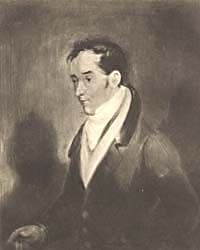 |
Scott first met James Ballantyne (1772-1833) when
attending Kelso Grammar School in 1783 (see School
and University). The oldest son of a thriving local merchant,
he shared Scott's love of literature, and the two rapidly became
good friends. Like Scott, James went on to study Law at Edinburgh
University, returning to Kelso in 1795 to set up in practice
as a solicitor. The following year he launched the staunchly
pro-Tory newspaper the Kelso Mail, which he both edited
and printed. |
In 1799, James privately printed the two pamphlets with which
Scott began his writing career: An Apology for Tales of Terror
(containing ballads and translations intended for publication in
Matthew Gregory
Lewis's much-delayed anthology Tales of Wonder)
and the ballad 'The
Eve of St. John' (see Literary Beginnings).
Thus began a literary and business partnership that would last
Scott's
lifetime. Scott was so pleased with the typographical excellence
of these two slim volumes that he offered James the opportunity
of printing the collection of Border ballads that he was in the
process of gathering. When these eventually appeared as the two
large octavo volumes of Minstrelsy
of the Scottish Border (1802), there was general astonishment
in the British book-trade that a small-town printer could produce
work of such quality. Scott immediately urged his friend to relocate
to Edinburgh, but James wished first to train up the younger
of
his two brothers, Alexander ('Sandy'), to take over the running
of the Kelso Mail. Sandy, father of the Victorian children's
writer, R.M. Ballantyne, would eventually buy James's entire
interest
in the Kelso Mail in 1806.
|
|
Click on the thumbnail to view a full-size
facsimile of the front page of the first issue of the Kelso
Mail (April 13, 1797). The March 1798 issue of the Kelso
Mail contained 'The Erl-King', Scott's translation of
a Goethe ballad.
|
Scott finally persuaded James to move to Edinburgh in 1803, loaning
him £500 to increase the liquid capital of his business. James
initially set up his presses in two small rooms in Holyrood House,
but thriving business soon led him to seek larger premises. Orders
flooded in from Edinburgh publishers and Scott was instrumental
in securing for Ballantyne the right to print Session papers (see
Professional Life). James first moved to
Foulis Close in the Canongate then, in 1805, to Paul's Work, situated
between the Canongate and Leith Wynd.
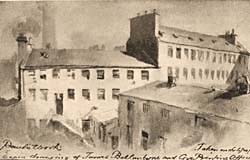 |
Click on the thumbnail to see a full-scale reproduction
of a sepia drawing of James Ballantyne & Co's Printing Office
at Paul's Work by an unknown artist. |
In that same year, though, the unprecedented success of The
Lay of the Last Minstrel,
printed by Ballantyne for Archibald Constable, severely strained
the small firm's financial resources. Printing jobs for other publishers
were delayed for want of capital to purchase materials (paper, inks,
type-faces, extra presses). Customers habitually demanded generous
credit before placing orders so money was slow coming in. However
prosperous the business appeared, Ballantyne sometimes lacked the
ready funds to pay his employees' wages. He thus requested a further
loan from Scott. Scott had recently been left £5,000 on the
death of his uncle, Robert Scott, and grasped the opportunity to
obtain a share in a business with excellent long-term prospects.
He offered to inject further capital on condition of being made
a partner. An agreement was signed on May 26, 1805, whereby Scott
advanced a further £1,500 (his original £500 loan being
converted into share capital) and became owner of a third of the
company's stock. The arrangement was kept a close secret from all
but Scott's friend Will Erskine.
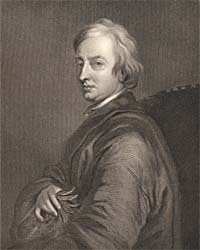 With
the aid of Scott's capital the press continued to prosper. Scott
threw himself into a great deal of editorial work on scholarly and
antiquarian volumes which he insisted must be printed by James Ballantyne
and Co. Scott's achievements as an editor are perhaps the most overlooked
aspect of his literary career. Most significant in these years was
the eighteen-volume set of the works of John Dryden (portrayed,
left) who many critics have seen as Scott's role model as a professional
writer. Other works edited or part-edited by Scott include Memoirs
of Captain George Carleton, Memoirs of Robert Carey,
State Papers and Letters of Sir Ralph Sadler, and Joseph
Strutt's Queenhoo-Hall (see Scott the
Novelist). These all brought considerable profits to Ballantyne
and Co. (and, by extension to Scott himself) but little for the
publishers involved. With
the aid of Scott's capital the press continued to prosper. Scott
threw himself into a great deal of editorial work on scholarly and
antiquarian volumes which he insisted must be printed by James Ballantyne
and Co. Scott's achievements as an editor are perhaps the most overlooked
aspect of his literary career. Most significant in these years was
the eighteen-volume set of the works of John Dryden (portrayed,
left) who many critics have seen as Scott's role model as a professional
writer. Other works edited or part-edited by Scott include Memoirs
of Captain George Carleton, Memoirs of Robert Carey,
State Papers and Letters of Sir Ralph Sadler, and Joseph
Strutt's Queenhoo-Hall (see Scott the
Novelist). These all brought considerable profits to Ballantyne
and Co. (and, by extension to Scott himself) but little for the
publishers involved.
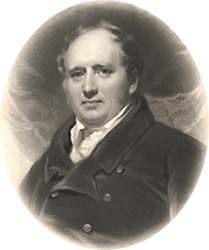 The
press's greatest success in these years, however, was Scott's second
narrative poem Marmion
(1808) which proved even more popular than The Lay of the Last
Minstrel. Marmion was printed by Ballantyne for the publisher
Archibald Constable (portrayed, right) but Scott was now keen to
distance himself from Constable. He detested the Whig politics of
Constable's Edinburgh Review and had been particularly incensed
by Francis Jeffrey's condemnation of British intervention in the
Peninsular War which had appeared on its pages. He had also been
hurt by Jeffrey's high-handed critique of Marmion. Keen to
partake of the huge profits with which he was currently lining Constable's
pockets, Scott decided to set up a rival publishing house. Looking
around for a capable manager, his choice fell on the middle Ballantyne
brother, John. The
press's greatest success in these years, however, was Scott's second
narrative poem Marmion
(1808) which proved even more popular than The Lay of the Last
Minstrel. Marmion was printed by Ballantyne for the publisher
Archibald Constable (portrayed, right) but Scott was now keen to
distance himself from Constable. He detested the Whig politics of
Constable's Edinburgh Review and had been particularly incensed
by Francis Jeffrey's condemnation of British intervention in the
Peninsular War which had appeared on its pages. He had also been
hurt by Jeffrey's high-handed critique of Marmion. Keen to
partake of the huge profits with which he was currently lining Constable's
pockets, Scott decided to set up a rival publishing house. Looking
around for a capable manager, his choice fell on the middle Ballantyne
brother, John.
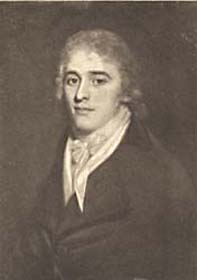 On
the face of it, John Ballantyne (1774-1821), with his hard-won reputation
as the black sheep of the family, was a perverse choice. After serving
an apprenticeship at a London banking house, he had been taken on
as a partner in his father's business in Kelso. In 1797, however,
the two men quarreled bitterly over John's choice of bride, and
John set up a rival store. Although it initially prospered, mismanagement,
womanizing and all-round high living brought John near ruin by 1806.
With difficulty, James dissuaded him from emigrating to the West
Indies and offered him a clerical post in his printing office, provided
that he mend his ways and make up with his now estranged wife. In
this new capacity John impressed Scott with his inventive approach
to book-keeping. Rapidly tiring of office drudgery, he leapt at
the chance to head the publishing firm which was founded in 1809.
Based in Hanover Street, it would trade under the name of John Ballantyne
and Co. Scott acquired a half-share in the business (again a closely
guarded secret), and James and John were allotted a quarter share
each. Profits were to be divided in the same proportion and matters
of policy to be decided jointly. Later in 1809 Scott renegotiated
his position with James Ballantyne's printing company, obtaining
a half-share in the business through a new injection of capital. On
the face of it, John Ballantyne (1774-1821), with his hard-won reputation
as the black sheep of the family, was a perverse choice. After serving
an apprenticeship at a London banking house, he had been taken on
as a partner in his father's business in Kelso. In 1797, however,
the two men quarreled bitterly over John's choice of bride, and
John set up a rival store. Although it initially prospered, mismanagement,
womanizing and all-round high living brought John near ruin by 1806.
With difficulty, James dissuaded him from emigrating to the West
Indies and offered him a clerical post in his printing office, provided
that he mend his ways and make up with his now estranged wife. In
this new capacity John impressed Scott with his inventive approach
to book-keeping. Rapidly tiring of office drudgery, he leapt at
the chance to head the publishing firm which was founded in 1809.
Based in Hanover Street, it would trade under the name of John Ballantyne
and Co. Scott acquired a half-share in the business (again a closely
guarded secret), and James and John were allotted a quarter share
each. Profits were to be divided in the same proportion and matters
of policy to be decided jointly. Later in 1809 Scott renegotiated
his position with James Ballantyne's printing company, obtaining
a half-share in the business through a new injection of capital.
John Ballantyne and Co.'s first publication, Scott's The
Lady of the Lake appeared in 1810. The huge profits led
the three partners into a wildly optimistic estimate of their future
prospects. The selection of future titles for publication fell to
Scott himself, who launched a series of commercially disastrous
titles. Profits from The Lady of the Lake were not ploughed
back into the business, and debts mounted rapidly. It was at this
juncture that Scott decided to throw further capital into the purchase
of Cartley Hole Farm, soon to be renamed Abbotsford.
Half of this sum was raised by John Ballantyne on the security of
the as yet unwritten Rokeby,
the poem to which Scott was looking both to cover his building expenses
and to bale out the publishing house.
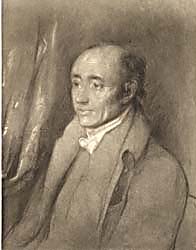 By
spring 1813, a series of banking crises had brought the war-ravaged
economy to a crisis. John Ballantyne and Co. had been forced to
sell some of the copyrights of Scott's works (their most valuable
assets) to raise ready capital. Rokeby, although a great
success by any other poet's standards, fell far short of being the
panacea to all the company's ills. The Ballantynes reluctantly approached
Archibald Constable who offered £1,300 for part of their unsold
stock, on condition that the firm wind up immediately and Scott
allow him to purchase a quarter share of the copyright of Rokeby
for an extra £700. Constable also agreed to prepare a report
into the financial state of both the printing and publishing companies,
concluding that they must raise £4,000 immediately to avoid
bankruptcy. Bankruptcy would have made public the secret arrangement
whereby Scott profited from the printing, publishing, and royalties
of every book he wrote. He would have been forced to resign as Clerk
to the Court of Session and thus lose his regular income. In desperation,
Scott turned to his patron, the Duke of Buccleuch (portrayed, above
right), who agreed to stand guarantor behind a redeemable annuity
for a sum of £4,000 (see Financial
Hardship). By
spring 1813, a series of banking crises had brought the war-ravaged
economy to a crisis. John Ballantyne and Co. had been forced to
sell some of the copyrights of Scott's works (their most valuable
assets) to raise ready capital. Rokeby, although a great
success by any other poet's standards, fell far short of being the
panacea to all the company's ills. The Ballantynes reluctantly approached
Archibald Constable who offered £1,300 for part of their unsold
stock, on condition that the firm wind up immediately and Scott
allow him to purchase a quarter share of the copyright of Rokeby
for an extra £700. Constable also agreed to prepare a report
into the financial state of both the printing and publishing companies,
concluding that they must raise £4,000 immediately to avoid
bankruptcy. Bankruptcy would have made public the secret arrangement
whereby Scott profited from the printing, publishing, and royalties
of every book he wrote. He would have been forced to resign as Clerk
to the Court of Session and thus lose his regular income. In desperation,
Scott turned to his patron, the Duke of Buccleuch (portrayed, above
right), who agreed to stand guarantor behind a redeemable annuity
for a sum of £4,000 (see Financial
Hardship).
Constable was to publish Scott next narrative poem The
Lord of the Isles and the first three Waverley Novels (Waverley,
Guy Mannering,
and The Antiquary).
After publishing the First Series of Tales of My Landlord
(The Black Dwarf and
Old Mortality)
with William Blackwood, Scott returned to Constable for Rob
Roy (1817), eventually persuading him to buy all of John
Ballantyne and Co.'s unsold stock. The contract for each new novel
stipulated that that the printing be undertaken by James Ballantyne
and Co. and that Constable had the right only to manage and sell
an agreed number of copies. In effect, then, Scott and James Ballantyne
controlled production.
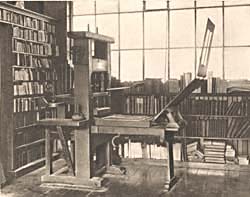 James's role extended far beyond that of business partner or printer.
His and Scott's was a unique literary relationship. Scott consulted
James on the artistic merit and likely commercial success of each
work. James read Scott's proofs, acting as editor rather than mere
proof-reader. He would point out inconsistencies in detail and gaps
in the text, insert names of speakers in dialogue, correct punctuation
and grammatical errors, and remove close verbal repetitions. The
annotated proofs were then sent back to Scott who made further alterations.
James made further editorial interventions on post-authorial proofs,
making changes that were probably never inspected by Scott. (Portrayed,
above left, is a wooden press used in printing the Waverley Novels
at the Ballantyne Press.)
James's role extended far beyond that of business partner or printer.
His and Scott's was a unique literary relationship. Scott consulted
James on the artistic merit and likely commercial success of each
work. James read Scott's proofs, acting as editor rather than mere
proof-reader. He would point out inconsistencies in detail and gaps
in the text, insert names of speakers in dialogue, correct punctuation
and grammatical errors, and remove close verbal repetitions. The
annotated proofs were then sent back to Scott who made further alterations.
James made further editorial interventions on post-authorial proofs,
making changes that were probably never inspected by Scott. (Portrayed,
above left, is a wooden press used in printing the Waverley Novels
at the Ballantyne Press.)
In autumn 1815 James proposed marriage to Christina Hogarth. Her
father would only consent if James could prove himself free from
debt. Scott agreed to discharge James from his liabilities for the
publishing house's debts on condition that Scott assume ownership
of James Ballantyne and Co., retaining James as a salaried manager.
The irrepressible John, meanwhile, had reinvented himself as a successful
auctioneer in his publishing house's old premises. He had even succeeded
in selling off a good deal of his own stock by putting it in other
people's sale catalogues. Esteeming his ability to drive a hard
bargain and his skill in confidential bill discounting, money-changing,
loan raising, and double accountancy, Scott continued to employ
him as his literary agent.
| As a theatre critic for the Edinburgh Evening
Courant, and patron of music and the arts, James soon acquired
a circle of like-minded friends. His rooms in St. John Street
near Paul's Work (portrayed, right) became a meeting place for
literary, theatrical, and concert-hall personalities. (Click here for a page, with photograph, on the history of St. John Street, published by Moray House School of Education.) Nonetheless
his financial circumstances remained straitened. He was constantly
under pressure to renew or pay back loans contracted in the
early days of Ballantyne Press. He had been forced to borrow
heavily in order to keep his capital in the enterprise on a
par with Scott's, and later in order to invest in John Ballantyne
and Co. |
|
James's financial worries eased when, in 1817, he purchased the
Edinburgh Weekly Journal along with his brother-in-law George
Hogarth. James assumed editorship and employed John as a musical
and drama critic, in which capacity he soon gained a considerable
reputation. Circulation rapidly expanded, and Hogarth ensured that
profits were ploughed back into the business. By now, however, John's
decades of hard living were catching up with him. After several
years of ill health, he died on June 16, 1821 of pulmonary consumption.
Shortly before his death, Scott had offered to write biographical
introductions for a project that John had long cherished: a series
of reprints of popular novels and romances at readily affordable
prices. Scott saw through the publication of 'Ballantyne's Novelists'
Library' in memory of his dead friend.
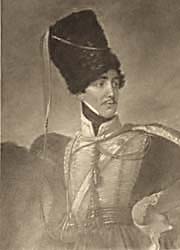 Scott
now promoted James Ballantyne from manager of the printing business
to personal agent and partner, while Sandy Ballantyne took over
the editorship of the Weekly Journal. The Ballantyne Press
was massively in demand, printing works for publishing houses both
north and south of the Border, and cornering the market for printing
legal stationary and official documents thanks to Scott's influence.
But money that should have gone on repaying loans had gone instead
to pay for work on Abbotsford. Ballantyne was quite aware that Scott
had run up vast debts in the company's name but assumed that the
land and buildings of Abbotsford were the firm's security. Unknown
to James, though, Scott settled the whole estate on his newly married
son, Walter (portrayed, above left) in 1825, thus putting it beyond
the reach of creditors. Scott
now promoted James Ballantyne from manager of the printing business
to personal agent and partner, while Sandy Ballantyne took over
the editorship of the Weekly Journal. The Ballantyne Press
was massively in demand, printing works for publishing houses both
north and south of the Border, and cornering the market for printing
legal stationary and official documents thanks to Scott's influence.
But money that should have gone on repaying loans had gone instead
to pay for work on Abbotsford. Ballantyne was quite aware that Scott
had run up vast debts in the company's name but assumed that the
land and buildings of Abbotsford were the firm's security. Unknown
to James, though, Scott settled the whole estate on his newly married
son, Walter (portrayed, above left) in 1825, thus putting it beyond
the reach of creditors.
Thus in the financial crisis of 1826, when the failure of Hurst,
Robinson & Company brought in its wake that of Archibald Constable
and the Ballantyne Press (see Financial Hardship).
James found himself liable for half of the company's debts. He was
forced to sell his new home and all the family valuables but permitted
to continue living at St. John Street. Under the surveillance of
the trust appointed to administer Scott's earnings, James was permitted
to stay on as manager of the printing business. A salary of £400
p.a. with no benefits meant a steep decline in his standard of living.
Sandy Ballantyne, who had invested all his own spare capital in
the Ballantyne Press, was permitted to resume management of the
Edinburgh Weekly Journal.
The fortunes of the surviving Ballantyne brothers gradually revived.
Many Edinburgh businessmen felt that James bore little guilt in
the collapse of his firm, pointing instead to Scott's incessant
demand for funds. Soon, Alexander Cowan, chairman of Scott's trustees,
was sufficiently confident to buy the printing house as a going
concern for £10,000 in Ballantyne's name. James contracted
to repay him the capital sum with interest over the coming years.
Shortly afterwards Sandy was admitted into partnership. The firm
gradually improved its turnover, and the loan was repaid by the
end of 1832.
| Although Scott had no official business relationship with
James Ballantyne & Co. after 1826, loyalty led him to insist
that his new publisher Robert Cadell (portrayed, right) continue
to use the press. It appears that in the final years of Scott's
life, relations with James began to cool. Scott was hurt by
his adverse criticism of Anne
of Geierstein and Count
Robert of Paris and appalled by his conversion to Whig
politics and evangelical religion. Cadell, who had little time
for the Ballantynes and thought their typographical prowess
overrated, sought to prise them further apart by using James
to convey his own reservations about Scott's later works. |
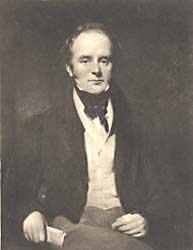 |
James, who had been devastated by the loss of his wife in 1829,
died shortly after Scott on January 26, 1833. His son, John Alexander
Ballantyne, took over management of the Ballantyne Press with the
help of John Hughes (who had risen up from the post of compositor).
Business continued to thrive for a few years but by mid-century
they were suffering serious competition from other steam presses.
In Edinburgh, Blackwood's had emerged as serious rivals, and the
publishing world was increasingly centred on London. Their Edinburgh
printing works finally closed in 1916.
For further information on the Ballantyne brothers, consult the
following works in addition to those cited on the Bibliography
page:
- The Ballantyne Press and Its Founders, 1796-1908 (Edinburgh:
Ballantyne, Hanson & Co., 1909)
- The History of the Ballantyne Press and Its Connection with
Sir Walter Scott, Bart. (Edinburgh: Ballantyne Press, 1871)
- Quayle, Eric, Ballantyne the Brave: A Victorian Writer and
His Family (London: Rupert Hart-Davis, 1967)
Back to Biography Index
Last updated: 11-Dec-2007
© Edinburgh University Library
|
|


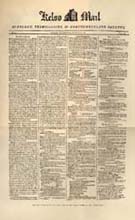

 With
the aid of Scott's capital the press continued to prosper. Scott
threw himself into a great deal of editorial work on scholarly and
antiquarian volumes which he insisted must be printed by James Ballantyne
and Co. Scott's achievements as an editor are perhaps the most overlooked
aspect of his literary career. Most significant in these years was
the eighteen-volume set of the works of John Dryden (portrayed,
left) who many critics have seen as Scott's role model as a professional
writer. Other works edited or part-edited by Scott include Memoirs
of Captain George Carleton, Memoirs of Robert Carey,
State Papers and Letters of Sir Ralph Sadler, and Joseph
Strutt's Queenhoo-Hall (see
With
the aid of Scott's capital the press continued to prosper. Scott
threw himself into a great deal of editorial work on scholarly and
antiquarian volumes which he insisted must be printed by James Ballantyne
and Co. Scott's achievements as an editor are perhaps the most overlooked
aspect of his literary career. Most significant in these years was
the eighteen-volume set of the works of John Dryden (portrayed,
left) who many critics have seen as Scott's role model as a professional
writer. Other works edited or part-edited by Scott include Memoirs
of Captain George Carleton, Memoirs of Robert Carey,
State Papers and Letters of Sir Ralph Sadler, and Joseph
Strutt's Queenhoo-Hall (see  The
press's greatest success in these years, however, was Scott's second
narrative poem
The
press's greatest success in these years, however, was Scott's second
narrative poem  On
the face of it, John Ballantyne (1774-1821), with his hard-won reputation
as the black sheep of the family, was a perverse choice. After serving
an apprenticeship at a London banking house, he had been taken on
as a partner in his father's business in Kelso. In 1797, however,
the two men quarreled bitterly over John's choice of bride, and
John set up a rival store. Although it initially prospered, mismanagement,
womanizing and all-round high living brought John near ruin by 1806.
With difficulty, James dissuaded him from emigrating to the West
Indies and offered him a clerical post in his printing office, provided
that he mend his ways and make up with his now estranged wife. In
this new capacity John impressed Scott with his inventive approach
to book-keeping. Rapidly tiring of office drudgery, he leapt at
the chance to head the publishing firm which was founded in 1809.
Based in Hanover Street, it would trade under the name of John Ballantyne
and Co. Scott acquired a half-share in the business (again a closely
guarded secret), and James and John were allotted a quarter share
each. Profits were to be divided in the same proportion and matters
of policy to be decided jointly. Later in 1809 Scott renegotiated
his position with James Ballantyne's printing company, obtaining
a half-share in the business through a new injection of capital.
On
the face of it, John Ballantyne (1774-1821), with his hard-won reputation
as the black sheep of the family, was a perverse choice. After serving
an apprenticeship at a London banking house, he had been taken on
as a partner in his father's business in Kelso. In 1797, however,
the two men quarreled bitterly over John's choice of bride, and
John set up a rival store. Although it initially prospered, mismanagement,
womanizing and all-round high living brought John near ruin by 1806.
With difficulty, James dissuaded him from emigrating to the West
Indies and offered him a clerical post in his printing office, provided
that he mend his ways and make up with his now estranged wife. In
this new capacity John impressed Scott with his inventive approach
to book-keeping. Rapidly tiring of office drudgery, he leapt at
the chance to head the publishing firm which was founded in 1809.
Based in Hanover Street, it would trade under the name of John Ballantyne
and Co. Scott acquired a half-share in the business (again a closely
guarded secret), and James and John were allotted a quarter share
each. Profits were to be divided in the same proportion and matters
of policy to be decided jointly. Later in 1809 Scott renegotiated
his position with James Ballantyne's printing company, obtaining
a half-share in the business through a new injection of capital. By
spring 1813, a series of banking crises had brought the war-ravaged
economy to a crisis. John Ballantyne and Co. had been forced to
sell some of the copyrights of Scott's works (their most valuable
assets) to raise ready capital. Rokeby, although a great
success by any other poet's standards, fell far short of being the
panacea to all the company's ills. The Ballantynes reluctantly approached
Archibald Constable who offered £1,300 for part of their unsold
stock, on condition that the firm wind up immediately and Scott
allow him to purchase a quarter share of the copyright of Rokeby
for an extra £700. Constable also agreed to prepare a report
into the financial state of both the printing and publishing companies,
concluding that they must raise £4,000 immediately to avoid
bankruptcy. Bankruptcy would have made public the secret arrangement
whereby Scott profited from the printing, publishing, and royalties
of every book he wrote. He would have been forced to resign as Clerk
to the Court of Session and thus lose his regular income. In desperation,
Scott turned to his patron, the Duke of Buccleuch (portrayed, above
right), who agreed to stand guarantor behind a redeemable annuity
for a sum of £4,000 (see
By
spring 1813, a series of banking crises had brought the war-ravaged
economy to a crisis. John Ballantyne and Co. had been forced to
sell some of the copyrights of Scott's works (their most valuable
assets) to raise ready capital. Rokeby, although a great
success by any other poet's standards, fell far short of being the
panacea to all the company's ills. The Ballantynes reluctantly approached
Archibald Constable who offered £1,300 for part of their unsold
stock, on condition that the firm wind up immediately and Scott
allow him to purchase a quarter share of the copyright of Rokeby
for an extra £700. Constable also agreed to prepare a report
into the financial state of both the printing and publishing companies,
concluding that they must raise £4,000 immediately to avoid
bankruptcy. Bankruptcy would have made public the secret arrangement
whereby Scott profited from the printing, publishing, and royalties
of every book he wrote. He would have been forced to resign as Clerk
to the Court of Session and thus lose his regular income. In desperation,
Scott turned to his patron, the Duke of Buccleuch (portrayed, above
right), who agreed to stand guarantor behind a redeemable annuity
for a sum of £4,000 (see  James's role extended far beyond that of business partner or printer.
His and Scott's was a unique literary relationship. Scott consulted
James on the artistic merit and likely commercial success of each
work. James read Scott's proofs, acting as editor rather than mere
proof-reader. He would point out inconsistencies in detail and gaps
in the text, insert names of speakers in dialogue, correct punctuation
and grammatical errors, and remove close verbal repetitions. The
annotated proofs were then sent back to Scott who made further alterations.
James made further editorial interventions on post-authorial proofs,
making changes that were probably never inspected by Scott. (Portrayed,
above left, is a wooden press used in printing the Waverley Novels
at the Ballantyne Press.)
James's role extended far beyond that of business partner or printer.
His and Scott's was a unique literary relationship. Scott consulted
James on the artistic merit and likely commercial success of each
work. James read Scott's proofs, acting as editor rather than mere
proof-reader. He would point out inconsistencies in detail and gaps
in the text, insert names of speakers in dialogue, correct punctuation
and grammatical errors, and remove close verbal repetitions. The
annotated proofs were then sent back to Scott who made further alterations.
James made further editorial interventions on post-authorial proofs,
making changes that were probably never inspected by Scott. (Portrayed,
above left, is a wooden press used in printing the Waverley Novels
at the Ballantyne Press.)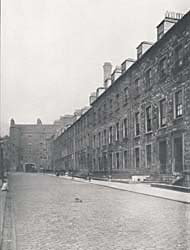
 Scott
now promoted James Ballantyne from manager of the printing business
to personal agent and partner, while Sandy Ballantyne took over
the editorship of the Weekly Journal. The Ballantyne Press
was massively in demand, printing works for publishing houses both
north and south of the Border, and cornering the market for printing
legal stationary and official documents thanks to Scott's influence.
But money that should have gone on repaying loans had gone instead
to pay for work on Abbotsford. Ballantyne was quite aware that Scott
had run up vast debts in the company's name but assumed that the
land and buildings of Abbotsford were the firm's security. Unknown
to James, though, Scott settled the whole estate on his newly married
son, Walter (portrayed, above left) in 1825, thus putting it beyond
the reach of creditors.
Scott
now promoted James Ballantyne from manager of the printing business
to personal agent and partner, while Sandy Ballantyne took over
the editorship of the Weekly Journal. The Ballantyne Press
was massively in demand, printing works for publishing houses both
north and south of the Border, and cornering the market for printing
legal stationary and official documents thanks to Scott's influence.
But money that should have gone on repaying loans had gone instead
to pay for work on Abbotsford. Ballantyne was quite aware that Scott
had run up vast debts in the company's name but assumed that the
land and buildings of Abbotsford were the firm's security. Unknown
to James, though, Scott settled the whole estate on his newly married
son, Walter (portrayed, above left) in 1825, thus putting it beyond
the reach of creditors. 